jump start FORD E SERIES 2004 4.G Owners Manual
[x] Cancel search | Manufacturer: FORD, Model Year: 2004, Model line: E SERIES, Model: FORD E SERIES 2004 4.GPages: 240, PDF Size: 3.62 MB
Page 2 of 240
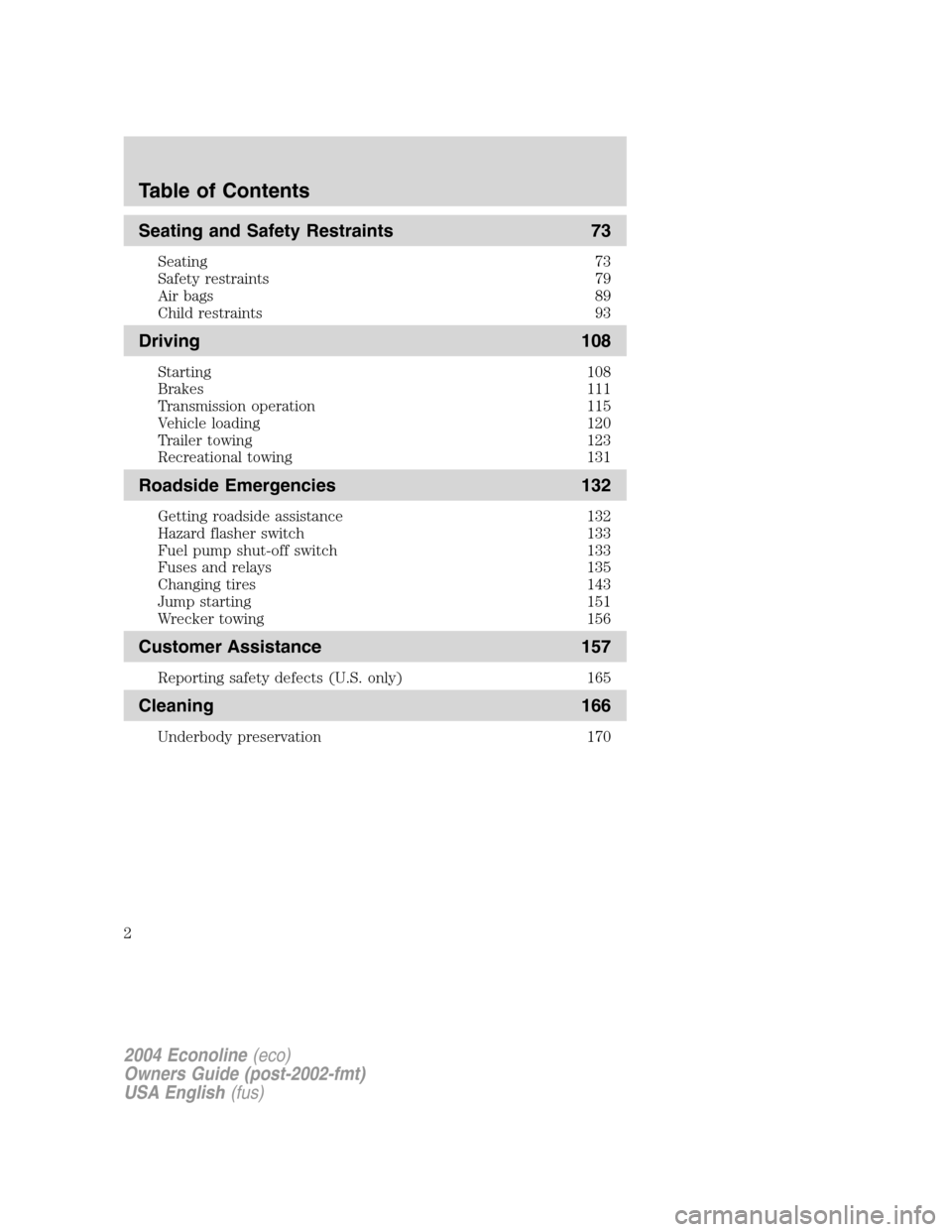
Seating and Safety Restraints 73
Seating 73
Safety restraints 79
Air bags 89
Child restraints 93
Driving 108
Starting 108
Brakes 111
Transmission operation 115
Vehicle loading 120
Trailer towing 123
Recreational towing 131
Roadside Emergencies 132
Getting roadside assistance 132
Hazard flasher switch 133
Fuel pump shut-off switch 133
Fuses and relays 135
Changing tires 143
Jump starting 151
Wrecker towing 156
Customer Assistance 157
Reporting safety defects (U.S. only) 165
Cleaning 166
Underbody preservation 170
2004 Econoline(eco)
Owners Guide (post-2002-fmt)
USA English(fus)
Table of Contents
2
Page 132 of 240
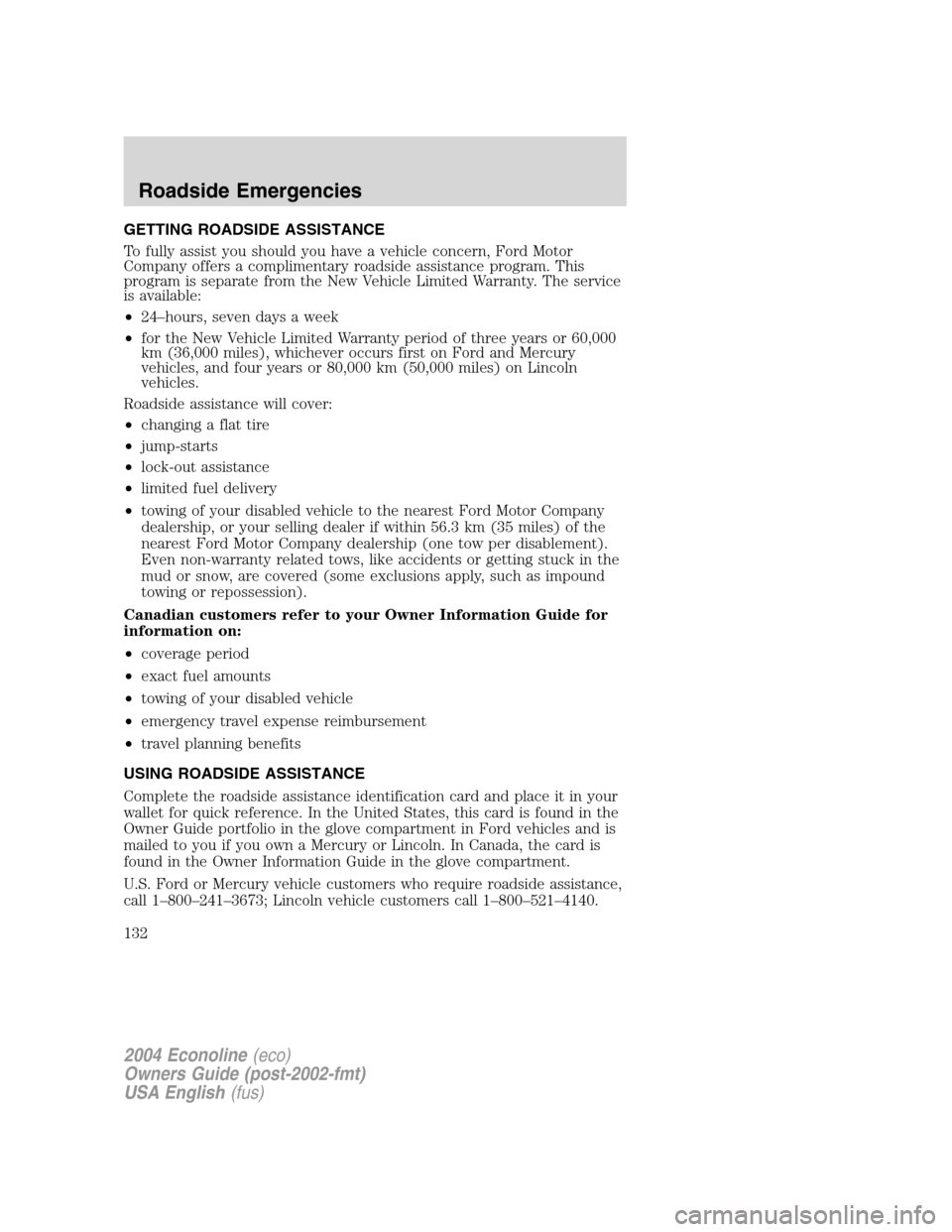
GETTING ROADSIDE ASSISTANCE
To fully assist you should you have a vehicle concern, Ford Motor
Company offers a complimentary roadside assistance program. This
program is separate from the New Vehicle Limited Warranty. The service
is available:
•24–hours, seven days a week
•for the New Vehicle Limited Warranty period of three years or 60,000
km (36,000 miles), whichever occurs first on Ford and Mercury
vehicles, and four years or 80,000 km (50,000 miles) on Lincoln
vehicles.
Roadside assistance will cover:
•changing a flat tire
•jump-starts
•lock-out assistance
•limited fuel delivery
•towing of your disabled vehicle to the nearest Ford Motor Company
dealership, or your selling dealer if within 56.3 km (35 miles) of the
nearest Ford Motor Company dealership (one tow per disablement).
Even non-warranty related tows, like accidents or getting stuck in the
mud or snow, are covered (some exclusions apply, such as impound
towing or repossession).
Canadian customers refer to your Owner Information Guide for
information on:
•coverage period
•exact fuel amounts
•towing of your disabled vehicle
•emergency travel expense reimbursement
•travel planning benefits
USING ROADSIDE ASSISTANCE
Complete the roadside assistance identification card and place it in your
wallet for quick reference. In the United States, this card is found in the
Owner Guide portfolio in the glove compartment in Ford vehicles and is
mailed to you if you own a Mercury or Lincoln. In Canada, the card is
found in the Owner Information Guide in the glove compartment.
U.S. Ford or Mercury vehicle customers who require roadside assistance,
call 1–800–241–3673; Lincoln vehicle customers call 1–800–521–4140.
2004 Econoline(eco)
Owners Guide (post-2002-fmt)
USA English(fus)
Roadside Emergencies
132
Page 151 of 240
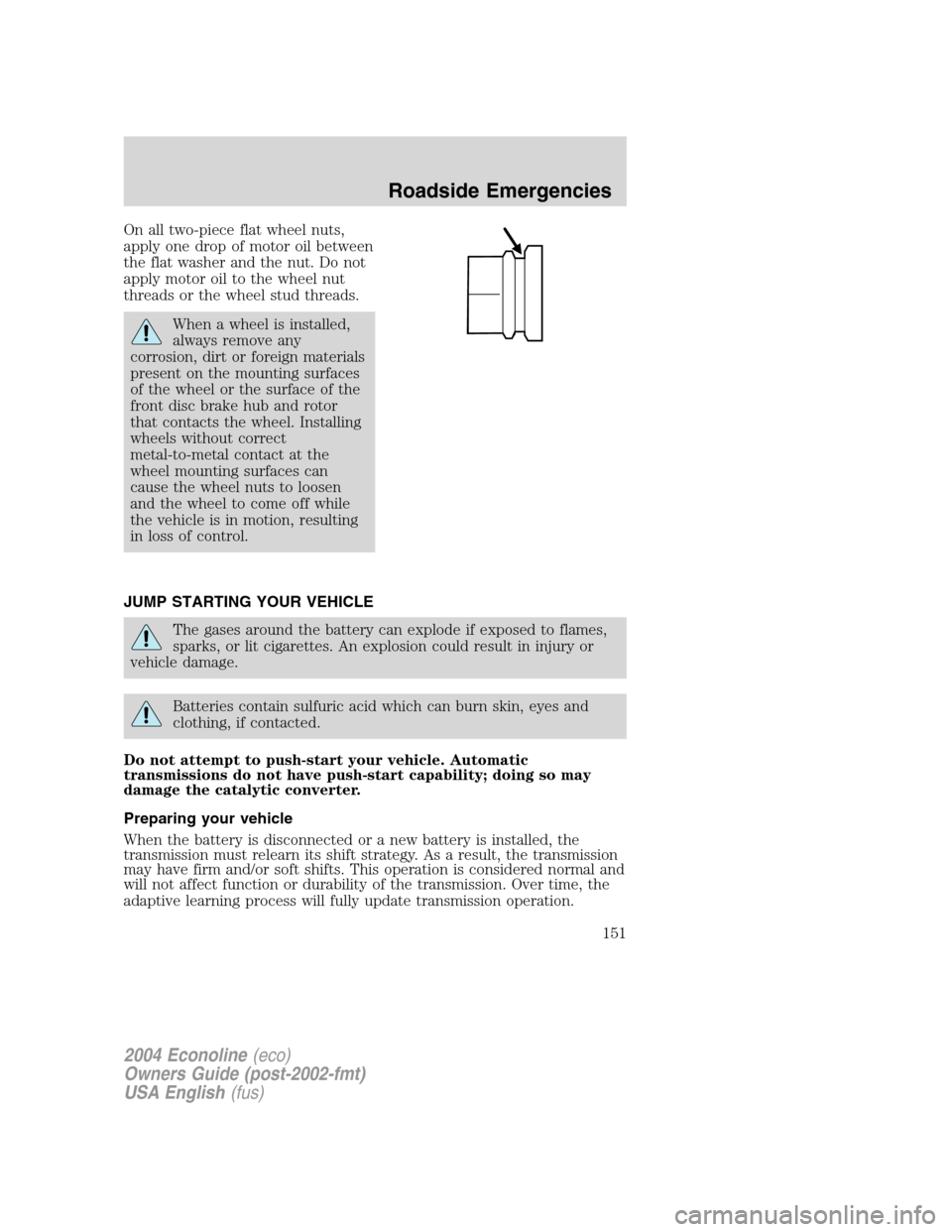
On all two-piece flat wheel nuts,
apply one drop of motor oil between
the flat washer and the nut. Do not
apply motor oil to the wheel nut
threads or the wheel stud threads.
When a wheel is installed,
always remove any
corrosion, dirt or foreign materials
present on the mounting surfaces
of the wheel or the surface of the
front disc brake hub and rotor
that contacts the wheel. Installing
wheels without correct
metal-to-metal contact at the
wheel mounting surfaces can
cause the wheel nuts to loosen
and the wheel to come off while
the vehicle is in motion, resulting
in loss of control.
JUMP STARTING YOUR VEHICLE
The gases around the battery can explode if exposed to flames,
sparks, or lit cigarettes. An explosion could result in injury or
vehicle damage.
Batteries contain sulfuric acid which can burn skin, eyes and
clothing, if contacted.
Do not attempt to push-start your vehicle. Automatic
transmissions do not have push-start capability; doing so may
damage the catalytic converter.
Preparing your vehicle
When the battery is disconnected or a new battery is installed, the
transmission must relearn its shift strategy. As a result, the transmission
may have firm and/or soft shifts. This operation is considered normal and
will not affect function or durability of the transmission. Over time, the
adaptive learning process will fully update transmission operation.
2004 Econoline(eco)
Owners Guide (post-2002-fmt)
USA English(fus)
Roadside Emergencies
151
Page 152 of 240
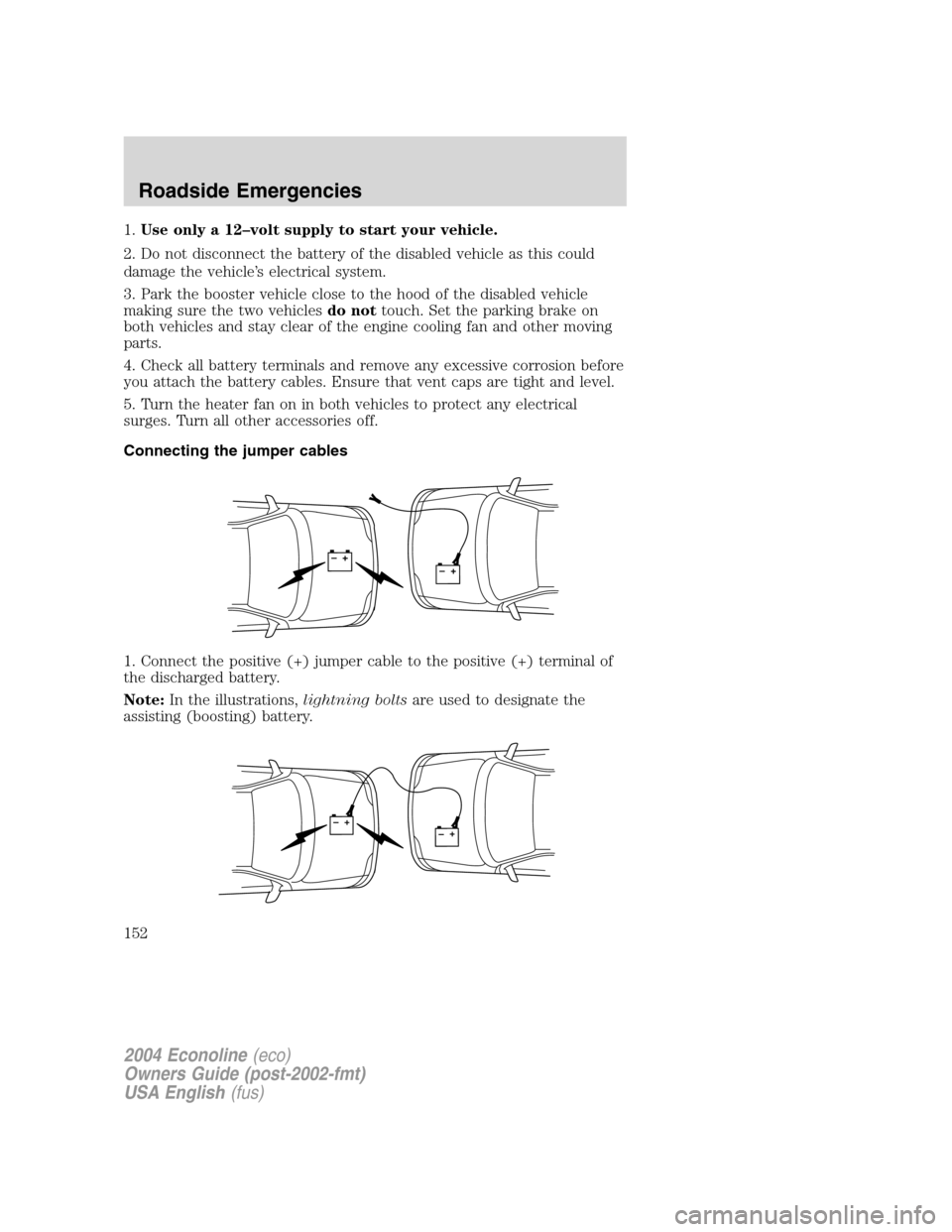
1.Use only a 12–volt supply to start your vehicle.
2. Do not disconnect the battery of the disabled vehicle as this could
damage the vehicle’s electrical system.
3. Park the booster vehicle close to the hood of the disabled vehicle
making sure the two vehiclesdo nottouch. Set the parking brake on
both vehicles and stay clear of the engine cooling fan and other moving
parts.
4. Check all battery terminals and remove any excessive corrosion before
you attach the battery cables. Ensure that vent caps are tight and level.
5. Turn the heater fan on in both vehicles to protect any electrical
surges. Turn all other accessories off.
Connecting the jumper cables
1. Connect the positive (+) jumper cable to the positive (+) terminal of
the discharged battery.
Note:In the illustrations,lightning boltsare used to designate the
assisting (boosting) battery.
+–+–
+–+–
2004 Econoline(eco)
Owners Guide (post-2002-fmt)
USA English(fus)
Roadside Emergencies
152
Page 153 of 240

2. Connect the other end of the positive (+) cable to the positive (+)
terminal of the assisting battery.
3. Connect the negative (-) cable to the negative (-) terminal of the
assisting battery.
4. Make the final connection of the negative (-) cable to an exposed
metal part of the stalled vehicle’s engine, away from the battery and the
carburetor/fuel injection system.Do notuse fuel lines, engine rocker
covers or the intake manifold asgroundingpoints.
Do not connect the end of the second cable to the negative (-)
terminal of the battery to be jumped. A spark may cause an
explosion of the gases that surround the battery.
5. Ensure that the cables are clear of fan blades, belts, moving parts of
both engines, or any fuel delivery system parts.
Jump starting
1. Start the engine of the booster vehicle and run the engine at
moderately increased speed.
+–+–
+–+–
2004 Econoline(eco)
Owners Guide (post-2002-fmt)
USA English(fus)
Roadside Emergencies
153
Page 154 of 240
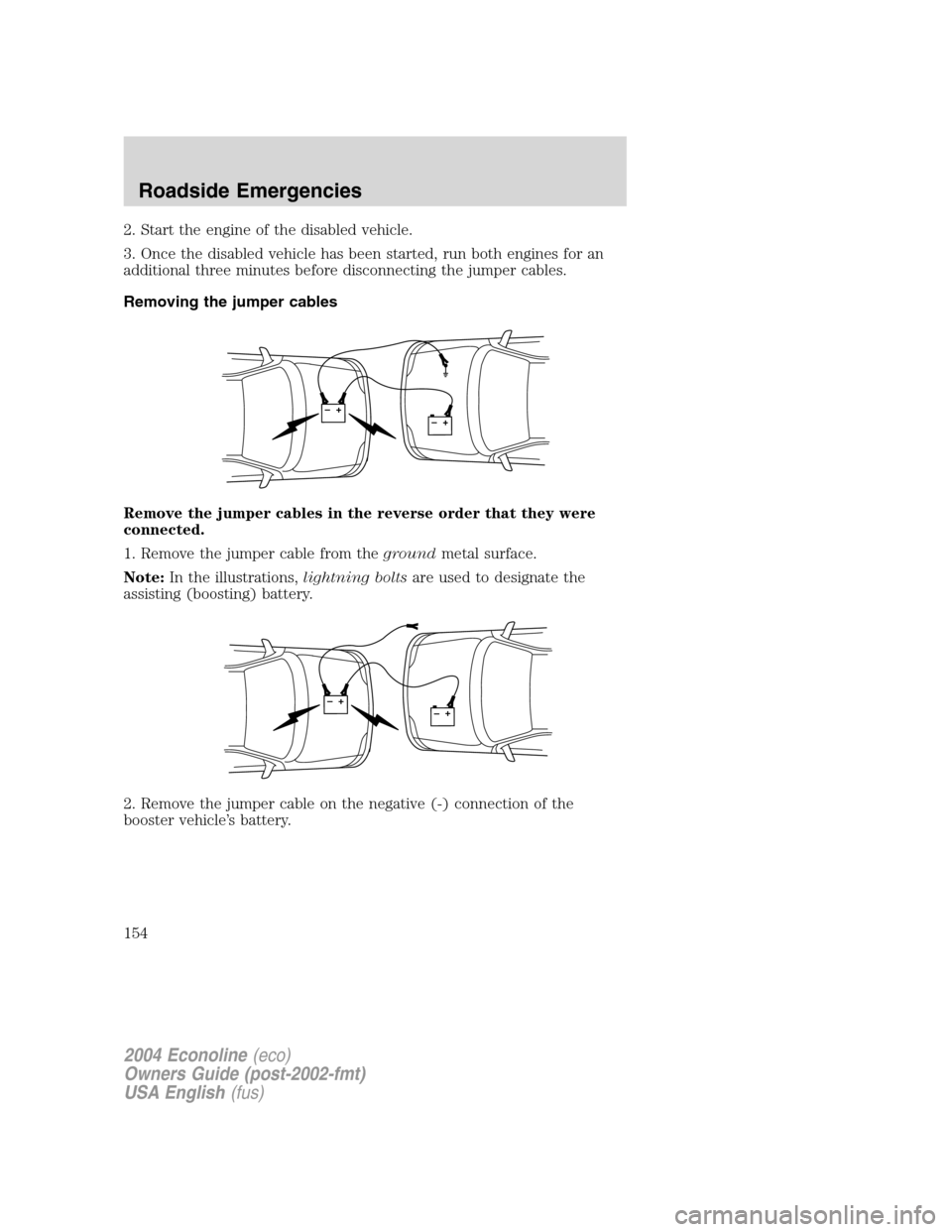
2. Start the engine of the disabled vehicle.
3. Once the disabled vehicle has been started, run both engines for an
additional three minutes before disconnecting the jumper cables.
Removing the jumper cables
Remove the jumper cables in the reverse order that they were
connected.
1. Remove the jumper cable from thegroundmetal surface.
Note:In the illustrations,lightning boltsare used to designate the
assisting (boosting) battery.
2. Remove the jumper cable on the negative (-) connection of the
booster vehicle’s battery.
+–+–
+–+–
2004 Econoline(eco)
Owners Guide (post-2002-fmt)
USA English(fus)
Roadside Emergencies
154
Page 155 of 240

3. Remove the jumper cable from the positive (+) terminal of the booster
vehicle’s battery.
4. Remove the jumper cable from the positive (+) terminal of the
disabled vehicle’s battery.
After the disabled vehicle has been started and the jumper cables
removed, allow it to idle for several minutes so the engine computer can
relearnits idle conditions.
+–+–
+–+–
2004 Econoline(eco)
Owners Guide (post-2002-fmt)
USA English(fus)
Roadside Emergencies
155
Page 235 of 240

washing ....................................166
waxing .....................................166
wheels ......................................167
wiper blades ............................168
Climate control (see Air
conditioning or Heating) ......47, 49
Clock ..........................15, 17, 19, 22
Clock adjust
AM/FM .......................................19
AM/FM Stereo ...........................19
AM/FM/CD .................................22
Compass, electronic ....................60
calibration .................................61
set zone adjustment .................61
Console
overhead ....................................59
Controls
power seat .................................74
Coolant
checking and adding ..............184
refill capacities ................187, 218
specifications ..................222, 225
Cruise control
(see Speed control) ....................65
Customer Assistance ................132
Ford accessories for your
vehicle .....................................170
Ford Extended Service
Plan ..........................................159
Getting assistance outside
the U.S. and Canada ..............163
Getting roadside assistance ...132
Getting the service you
need .........................................157
Ordering additional owner’s
literature .................................164
The Dispute Settlement
Board .......................................159Utilizing the
Mediation/Arbitration
Program ...................................162
D
Daytime running lamps
(see Lamps) ................................50
Dipstick
automatic transmission
fluid ..........................................200
engine oil .................................175
Doors
lubricant specifications ..........222
Driveline universal joint and
slip yoke ....................................200
Driving under special
conditions ..................................119
through water .........................119
E
Emergencies, roadside
jump-starting ..........................151
Emergency Flashers .................133
Emission control system ..........197
Engine ................................225–226
cleaning ...................................167
coolant .....................................184
diesel ...........................................6
fail-safe coolant ......................188
idle speed control ...................178
lubrication
specifications ..................222, 225
refill capacities ........................218
service points ..........................174
starting after a collision .........133
Engine block heater .................111
Engine oil ..................................175
2004 Econoline(eco)
Owners Guide (post-2002-fmt)
USA English(fus)
Index
235
Page 236 of 240
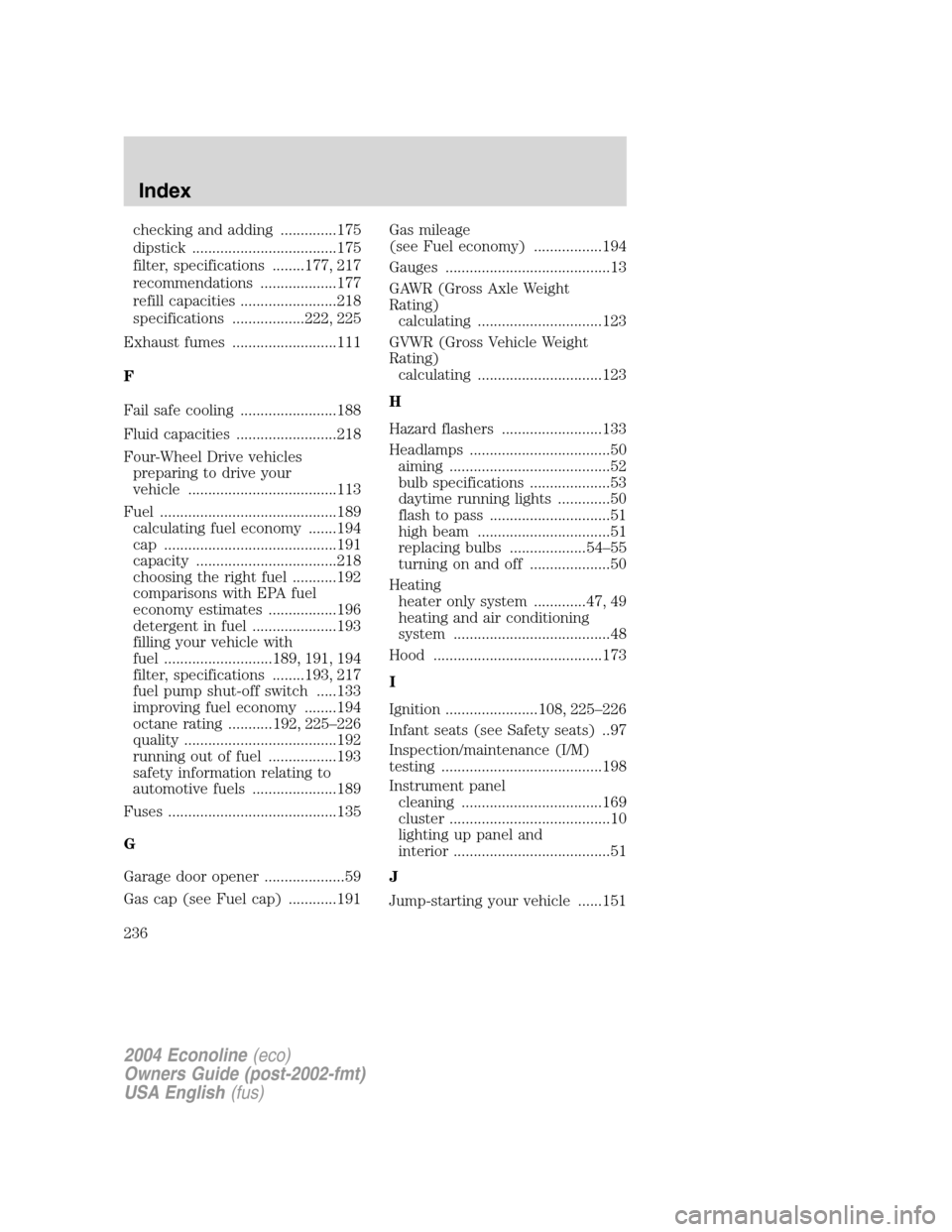
checking and adding ..............175
dipstick ....................................175
filter, specifications ........177, 217
recommendations ...................177
refill capacities ........................218
specifications ..................222, 225
Exhaust fumes ..........................111
F
Fail safe cooling ........................188
Fluid capacities .........................218
Four-Wheel Drive vehicles
preparing to drive your
vehicle .....................................113
Fuel ............................................189
calculating fuel economy .......194
cap ...........................................191
capacity ...................................218
choosing the right fuel ...........192
comparisons with EPA fuel
economy estimates .................196
detergent in fuel .....................193
filling your vehicle with
fuel ...........................189, 191, 194
filter, specifications ........193, 217
fuel pump shut-off switch .....133
improving fuel economy ........194
octane rating ...........192, 225–226
quality ......................................192
running out of fuel .................193
safety information relating to
automotive fuels .....................189
Fuses ..........................................135
G
Garage door opener ....................59
Gas cap (see Fuel cap) ............191Gas mileage
(see Fuel economy) .................194
Gauges .........................................13
GAWR (Gross Axle Weight
Rating)
calculating ...............................123
GVWR (Gross Vehicle Weight
Rating)
calculating ...............................123
H
Hazard flashers .........................133
Headlamps ...................................50
aiming ........................................52
bulb specifications ....................53
daytime running lights .............50
flash to pass ..............................51
high beam .................................51
replacing bulbs ...................54–55
turning on and off ....................50
Heating
heater only system .............47, 49
heating and air conditioning
system .......................................48
Hood ..........................................173
I
Ignition .......................108, 225–226
Infant seats (see Safety seats) ..97
Inspection/maintenance (I/M)
testing ........................................198
Instrument panel
cleaning ...................................169
cluster ........................................10
lighting up panel and
interior .......................................51
J
Jump-starting your vehicle ......151
2004 Econoline(eco)
Owners Guide (post-2002-fmt)
USA English(fus)
Index
236
Page 238 of 240
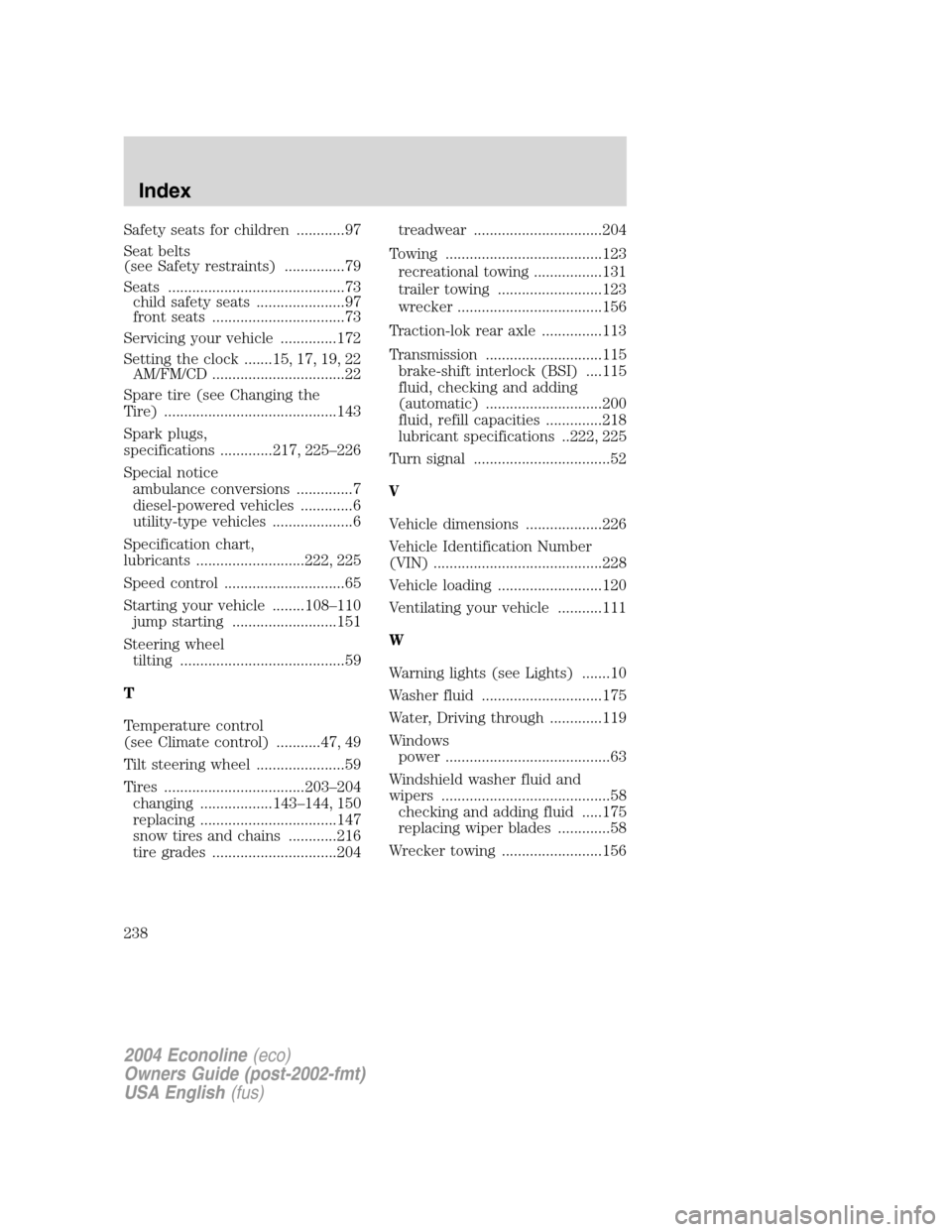
Safety seats for children ............97
Seat belts
(see Safety restraints) ...............79
Seats ............................................73
child safety seats ......................97
front seats .................................73
Servicing your vehicle ..............172
Setting the clock .......15, 17, 19, 22
AM/FM/CD .................................22
Spare tire (see Changing the
Tire) ...........................................143
Spark plugs,
specifications .............217, 225–226
Special notice
ambulance conversions ..............7
diesel-powered vehicles .............6
utility-type vehicles ....................6
Specification chart,
lubricants ...........................222, 225
Speed control ..............................65
Starting your vehicle ........108–110
jump starting ..........................151
Steering wheel
tilting .........................................59
T
Temperature control
(see Climate control) ...........47, 49
Tilt steering wheel ......................59
Tires ...................................203–204
changing ..................143–144, 150
replacing ..................................147
snow tires and chains ............216
tire grades ...............................204treadwear ................................204
Towing .......................................123
recreational towing .................131
trailer towing ..........................123
wrecker ....................................156
Traction-lok rear axle ...............113
Transmission .............................115
brake-shift interlock (BSI) ....115
fluid, checking and adding
(automatic) .............................200
fluid, refill capacities ..............218
lubricant specifications ..222, 225
Turn signal ..................................52
V
Vehicle dimensions ...................226
Vehicle Identification Number
(VIN) ..........................................228
Vehicle loading ..........................120
Ventilating your vehicle ...........111
W
Warning lights (see Lights) .......10
Washer fluid ..............................175
Water, Driving through .............119
Windows
power .........................................63
Windshield washer fluid and
wipers ..........................................58
checking and adding fluid .....175
replacing wiper blades .............58
Wrecker towing .........................156
2004 Econoline(eco)
Owners Guide (post-2002-fmt)
USA English(fus)
Index
238